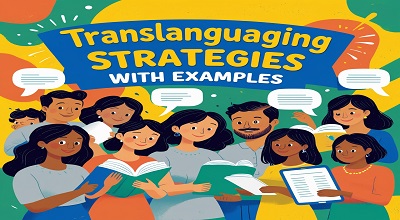Translanguaging Strategies
Translanguaging Strategies: Translanguaging is an innovative pedagogical approach that leverages students’ full linguistic repertoires to enhance learning. Unlike traditional bilingual education, which often separates languages, translanguaging encourages fluid language use, helping students make deeper connections between concepts.
With globalization and increasing multilingual classrooms, educators are adopting translanguaging strategies to support diverse learners. This blog explores the latest translanguaging strategies, their benefits, practical examples, and challenges.
What is Translanguaging?
Translanguaging refers to the dynamic process where multilingual speakers use their entire language repertoire to communicate and learn. Coined by Welsh educator Cen Williams, the concept challenges rigid language boundaries, promoting a more natural and inclusive way of learning.
Key Features of Translanguaging:
- Flexibility: Students switch between languages seamlessly.
- Cognitive Benefits: Enhances comprehension and critical thinking.
- Cultural Validation: Respects students’ linguistic identities.
Benefits of Translanguaging in Education
Research shows that translanguaging offers multiple advantages:
✅ Improved Comprehension: Students grasp complex concepts better when explained in their home language.
✅ Enhanced Engagement: Learners participate more actively when allowed to use familiar languages.
✅ Stronger Metacognition: Comparing languages helps develop deeper linguistic awareness.
✅ Inclusive Learning: Supports English Language Learners (ELLs) and multilingual students.
Key Translanguaging Strategies
Code-Switching and Mixing
Teachers and students alternate between languages within a conversation.
Example:
- A teacher explains a math problem in English but uses Spanish for clarification.
Multilingual Labeling
Classroom objects, charts, and displays include labels in multiple languages.
Example:
- A science poster has key terms in English, Arabic, and Mandarin.
Translanguaging in Group Work
Students collaborate using their preferred languages.
Example:
- A group discusses a project in Hindi and presents findings in English.
Using Multilingual Resources
Incorporating books, videos, and digital tools in different languages.
Example:
- Watching a history documentary in French with English subtitles.
Scaffolding with Home Languages
Teachers use students’ native languages to introduce new English vocabulary.
Example:
- Teaching the word “photosynthesis” by breaking it down into Greek roots (“photo” = light, “synthesis” = combining).
Examples of Translanguaging in the Classroom
1: Bilingual Storytelling
- A teacher reads a story in English and retells parts in Urdu to ensure understanding.
2: Multilingual Journals
- Students write journal entries using a mix of languages to express ideas freely.
3: Peer Translation
- Students translate instructions for classmates who are less proficient in English.
Challenges and Misconceptions
- Misconception: Translanguaging causes language confusion.
- Reality: It strengthens metalinguistic awareness.
- Challenge: Lack of teacher training in multilingual strategies.
- Solution: Professional development workshops on translanguaging.
Future of Translanguaging in Education
With AI and digital tools, translanguaging is evolving:
- AI Translation Apps help bridge language gaps.
- Virtual Exchange Programs connect multilingual classrooms globally.
Conclusion
Translanguaging transforms education by embracing linguistic diversity. By implementing these strategies, teachers can create more inclusive and effective learning environments.
